-
Countries
-
Data and Analysis
-
Special Focus
-
Crisis Responses
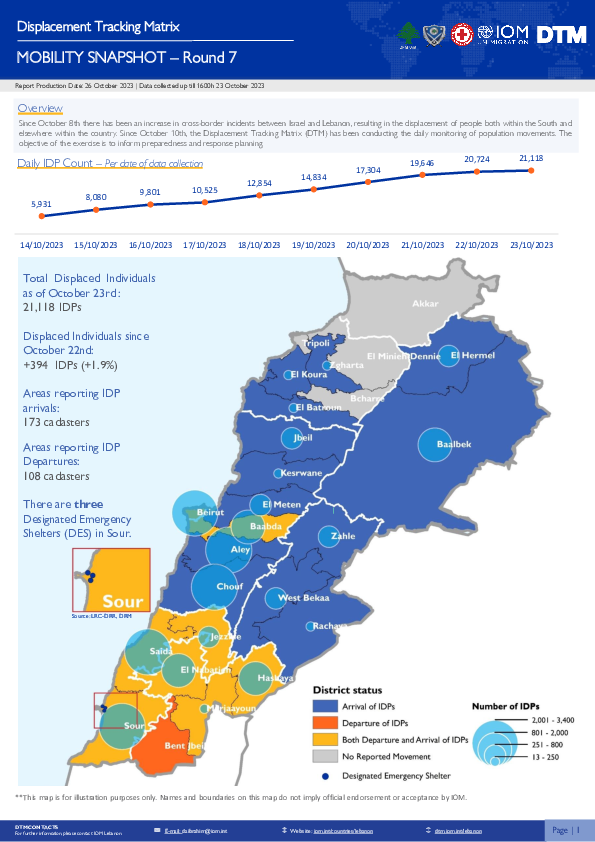
Contact
daibrahim@iom.int
Language
English
Location
Lebanon
Period Covered
Oct 10 2023
Oct 23 2023
Activity
- Mobility Tracking
- Baseline Assessment
Since October 8 there has been an increase in cross-border incidents between Israel and Lebanon, resulting in the displacement of people both within the South and elsewhere within the country. Since October 10, the Displacement Tracking Matrix (DTM) has been conducting the daily monitoring of population movements. The objective of the exercise is to inform preparedness and response planning.
Contact
DTMDRC@iom.int
Location
Democratic Republic of the Congo
Activity
- Mobility Tracking
- Baseline Assessment
Period Covered
Oct 14 2023 -Oct 24 2023
Since the start of the M23 crisis, IOM, through the DTM continues to conduct a series of rapid assessments, including emergency monitoring (EET/ERM), crisis analysis and recording with priority to responding to immediate information needs with a view to understanding travel dynamics and needs. This report presents the results of assessments carried out in the different areas of displacement and return between October 9 and 22, 2023.
Displacement data collected as part of this ninth crisis analysis shows a further increase in the number of displaced people compared to the previous publication. The number of internally displaced people increased from 824,381 to 908,920 as of October 22, 2023, an increase of 84,539 individuals or nine percent. This assessment made it possible to identify a total of 663,812 returnees (136,426 households) .
Population Groups
Survey Methodology
Unit of Analysis Or Observation
Type of Survey or Assessment
Keywords
Geographical Scope
Administrative boundaries with available data
The current dataset covers the following administrative boundaries

Contact
DTM Somalia, IOMSomaliaDTM@iom.int
Language
English
Location
Somalia
Period Covered
Oct 15 2023
Oct 21 2023
Activity
- Mobility Tracking
- Event Tracking
In response to the Somalia’s severe drought beginning in November 2021, DTM Somalia launched an Emergency Trends Tracking (ETT) tool first in Gedo and Bay regions in 2022, and subsequently in Hiraan, Banadir and Middle Shabelle regions in 2023 to monitor drought related displacement trends and hotspots in support of operational planning. However, during the first half of 2023, conflict and flooding displacements have been significant. Therefore, DTM restructured its ETT tool to capture multi-shock displacements (drought, flood, conflict and other) from October 2023.
ETT is a crisis-based tool that tracks sudden displacement triggered by specific events or emerging crises. The objective of ETT is to help prioritize humanitarian response and to enable partners to deliver rapid assistance.

Contact
DTM Yemen, DTMYemen@iom.int
Language
English
Location
Yemen
Period Covered
Oct 23 2023
Oct 25 2023
Activity
- Rapid Emergency Registration
- Mobility Tracking
On 23 October 2023, IOM Yemen DTM tracked 3,689 households (22,134 individuals) displaced due to Cyclone Tej in Al Maharah and Hadramawt on 22 October. Most people moved into/within the following governorates and districts:
- Al Maharah (3,384 HHs) – Haswin (1,815 HHs), Al Ghaydhah (1,123 HHs), Al Masilah (210 HHs) districts. All displacements in the governorate were internal.
- Hadramawt (305 HHs) – Ar Raydah wa Qussayar (305 HHs) district. All displacements in the governorate were internal.
Contact
DTM Sudan, DTMSudan@iom.int
Location
Sudan
Activity
- Mobility Tracking
- Baseline Assessment
Period Covered
Apr 15 2023 -Oct 19 2023
From 15 April 2023, armed clashes erupted between the Sudanese Armed Forces (SAF) and the Rapid Support Forces (RSF). Clashes initially took place in cities across Northern and Khartoum states, later spreading across the Darfur and Kordofan regions.
Key Findings
DTM Sudan estimates that 4,633,930 Individuals (924,091 Households) have been recently internally displaced.
The IDP caseload has been observed in 4,728 locations across all of Sudan’s 18 states.
The highest proportions of IDPs have been observed in River Nile (12.45%), South Darfur (11.09%), East Darfur (10.82%), Aj Jazirah (7.92%), Northern (7.82%), and North Darfur (7.34%).
Field teams report that the IDPs observed were originally displaced from eight states. The majority (3,182,405 IDPs, 68.68%) have been reportedly displaced from Khartoum state; followed by South Darfur (14.46%), North Darfur (7.86%), Central Darfur (3.98%), West Darfur (3.80%), South Kordofan (0.75%), North Kordofan (0.46%), and Aj Jazirah (0.01%).
IOM DTM also reports that an estimated 1,276,379 mixed cross-border movements have been made into neighbouring countries.
A more detailed version of this dataset is available, to get access kindly click on the "Request Access" button.
Population Groups
Survey Methodology
Unit of Analysis Or Observation
Type of Survey or Assessment
Keywords
Geographical Scope
Administrative boundaries with available data
The current dataset covers the following administrative boundaries
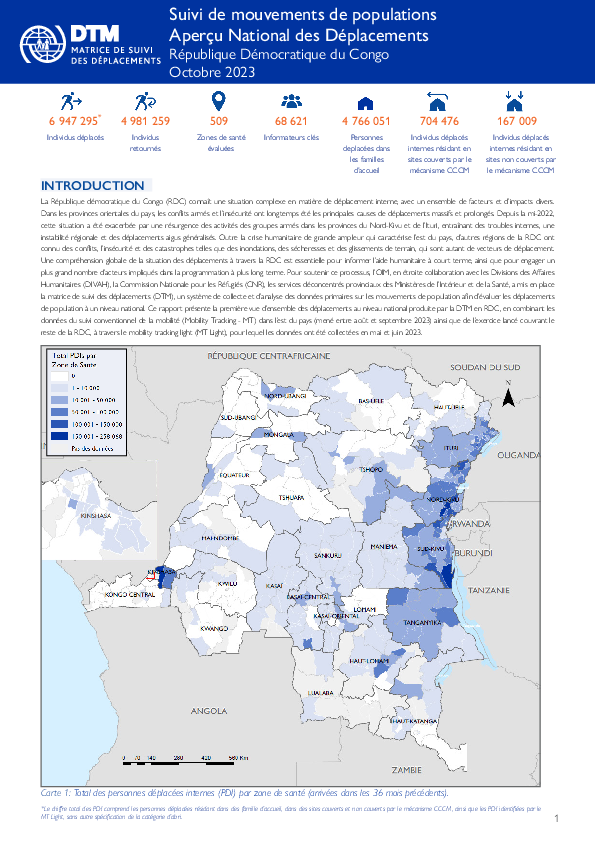
Contact
DTM DRC, iomdrcdtm@iom.int
Language
English
Location
Democratic Republic of the Congo
Period Covered
May 01 2023
Sep 12 2023
Activity
- Mobility Tracking
- Baseline Assessment
La République démocratique du Congo (RDC) connaît une situation complexe en matière de déplacement interne, avec un ensemble de facteurs et d’impacts divers. Dans les provinces orientales du pays, les conflits armés et l’insécurité ont longtemps été les principales causes de déplacements massifs et prolongés. Depuis la mi-2022, cette situation a été exacerbée par une résurgence des activités des groupes armés dans les provinces du Nord-Kivu et de l’Ituri, entraînant des troubles internes, une instabilité régionale et des déplacements aigus généralisés. Outre la crise humanitaire de grande ampleur qui caractérise l’est du pays, d’autres régions de la RDC ont connu des conflits, l’insécurité et des catastrophes telles que des inondations, des sécheresses et des glissements de terrain, qui sont autant de vecteurs de déplacement. Une compréhension globale de la situation des déplacements à travers la RDC est essentielle pour informer l’aide humanitaire à court terme, ainsi que pour engager un plus grand nombre d’acteurs impliqués dans la programmation à plus long terme. Pour soutenir ce processus, l’OIM, en étroite collaboration avec les Divisions des Affaires Humanitaires (DIVAH), la Commission Nationale pour les Réfugiés (CNR), les services déconcentrés provinciaux des Ministères de l’Intérieur et de la Santé, a mis en place la matrice de suivi des déplacements (DTM), un système de collecte et d’analyse des données primaires sur les mouvements de population afin d’évaluer les déplacements de population à un niveau national. Ce rapport présente la première vue d’ensemble des déplacements au niveau national produite par la DTM en RDC, en combinant les données du suivi conventionnel de la mobilité (Mobility Tracking - MT) dans l’est du pays (mené entre août et septembre 2023) ainsi que de l’exercice lancé couvrant le reste de la RDC, à travers le mobility tracking light (MT Light), pour lequel les données ont été collectées en mai et juin 2023.
Au niveau national, la DTM a identifié 6 947 295 personnes déplacées internes (PDI), principalement concentrées dans les quatre provinces orientales du Nord-Kivu (2 300 163 personnes), de l’Ituri (1 630 535), du Sud-Kivu (1 356 376) et du Tanganyika (350 462), ainsi que dans la province/ville de Kinshasa à l’ouest du pays (392 281). Ces cinq provinces représentent à elles seules la grande majorité (87%) des déplacements actuels en RDC. Les 21 provinces restantes représentent 13 pour cent du nombre total de personnes déplacées dans le pays (917 478 personnes).
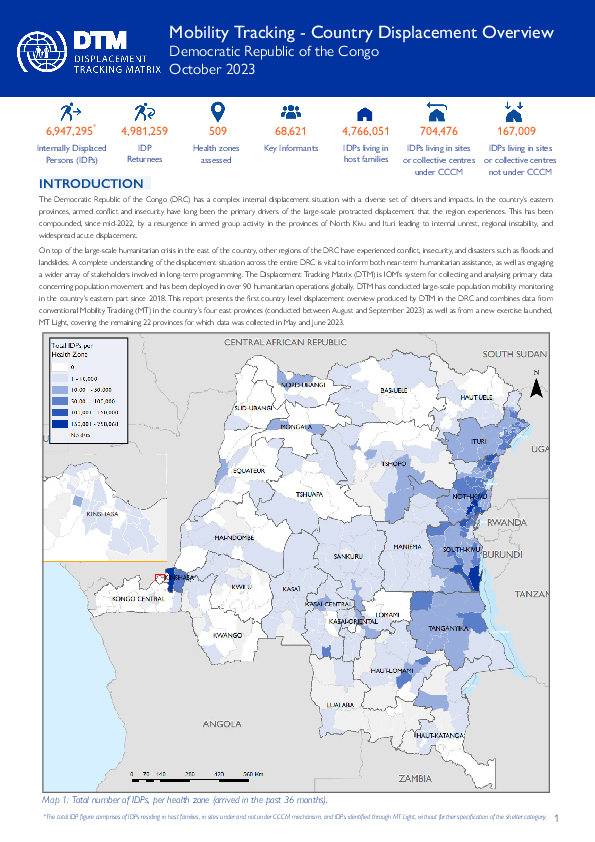
Contact
DTM DRC, iomdrcdtm@iom.int
Language
English
Location
Democratic Republic of the Congo
Period Covered
May 01 2023
Sep 12 2023
Activity
- Mobility Tracking
- Baseline Assessment
The Democratic Republic of the Congo (DRC) has a complex internal displacement situation with a diverse set of drivers and impacts. In the country’s eastern provinces, armed conflict and insecurity have long been the primary drivers of the large-scale protracted displacement that the region experiences. This has been compounded, since mid-2022, by a resurgence in armed group activity in the provinces of North Kivu and Ituri leading to internal unrest, regional instability, and widespread acute displacement. On top of the large-scale humanitarian crisis in the east of the country, other regions of the DRC have experienced conflict, insecurity, and disasters such as floods and landslides. A complete understanding of the displacement situation across the entire DRC is vital to inform both near-term humanitarian assistance, as well as engaging a wider array of stakeholders involved in long-term programming. The Displacement Tracking Matrix (DTM) is IOM’s system for collecting and analysing primary data concerning population movement and has been deployed in over 90 humanitarian operations globally. DTM has conducted large-scale population mobility monitoring in the country’s eastern part since 2018. This report presents the first country level displacement overview produced by DTM in the DRC and combines data from conventional Mobility Tracking (MT) in the country’s four east provinces (conducted between August and September 2023) as well as from a new exercise launched, MT Light, covering the remaining 22 provinces for which data was collected in May and June 2023.
At a national level, DTM identified 6,947,295 individual internally displaced persons (IDPs), primarily concentrated in the four eastern provinces of North Kivu (2,300,163 individuals), Ituri (1,630,535), South Kivu (1,356,376), and Tanganyika (350,462) as well as the province/city of Kinshasa in the west of the country (392,281). These five provinces alone account for the considerable majority (87%) of current displacement in the DRC. The remaining 21 provinces account for 13 per cent of the total number of IDPs in the country (917,478 individuals).
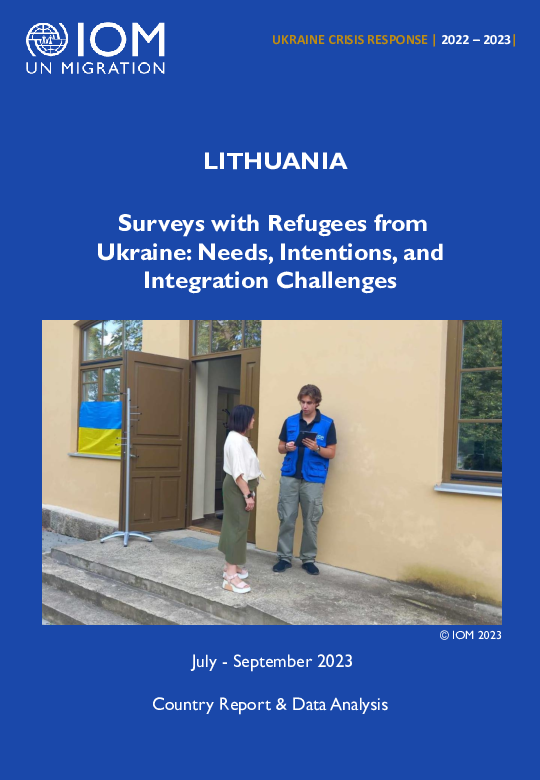
Contact
DTM Europe, DTMMediterranean@iom.int
Language
English
Location
Lithuania
Period Covered
Jul 01 2023
Sep 30 2023
Activity
- Survey
- Flow Monitoring
This report is based on a survey of displacement patterns, needs and intentions conducted by IOM’s Displacement Tracking Matrix (DTM) in the countries included in the Regional Response Plan for Ukraine in 2023: 6 countries neighbouring Ukraine – Belarus, Hungary, Poland, Republic of Moldova, Romania and Slovakia – and other 5 countries particularly impacted by the arrivals of refugees from Ukraine since the start of the war in February 2022 – Bulgaria, Czechia, Estonia, Latvia and Lithuania. The analysis presented in this report is based on data collected between July and September 2023.
Key Findings:
- Top oblasts of origin: Kharkivska (17%), Donetska (12%), Zaporizka (10%), Khersonska (9%), Dnipropetrovska (7%).
- Intentions to move: no intention to move (86%), intention to move within current country (3%), intention to move to another country (1%). Top 3 cited countries were Canada, Poland, and the United Kingdom.
- Employment status: employed (37%), unemployed and looking for a job (24%), retired (14%), parental leave (8%), student (8%).
- Top needs:* financial support (39%), health services (31%), personal hygiene and sanitary supplies (26%), medicine (26%), language courses (23%).
- Top areas of assistance received:* food products (91%), personal hygiene and sanitary supplies (72%), transportation (67%), clothes & shoes (58%).
*multiple answers possible
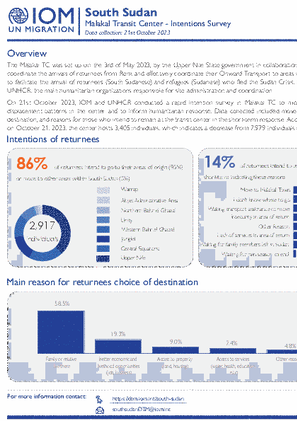
Contact
DTM South Sudan, SouthSudanDTM@iom.int
Language
English
Location
South Sudan
Period Covered
Oct 21 2023
Oct 21 2023
Activity
- Survey
- Return Intention
On 21st October 2023, IOM and partners (UNHCR, DRC, and ACTED) conducted a rapid intention survey in Malakal TC to monitor the population dynamics and displacement patterns in the center and to inform humanitarian response. Data collected included movement intentions, preferred intended destination, and reasons for those who intend to remain at the transit center in the short-term response. According to the head count, conducted on October 21, 2023, the center hosts 3,405 individuals, which is a decrease from 7,979 individuals in September 2023.

Contact
DTM South Sudan, SouthSudanDTM@iom.int
Language
English
Location
South Sudan
Period Covered
Sep 27 2023
Sep 27 2023
Activity
- Survey
- Return Intention
On 27 September 2023, IOM and partners conducted a rapid intention survey in Renk TC and its area adjacent. The partners included ACTED, Save the Children, Mentor Initiative, Plan International, ADRA, IRC, LWF and GOAL. The purpose of this exercise was to monitor the population dynamics and displacement trends in the center and to inform humanitarian response. . Data collected included movement intentions, preferred intended destination, and reasons for those that intend to remain at the transit center in the short term response.